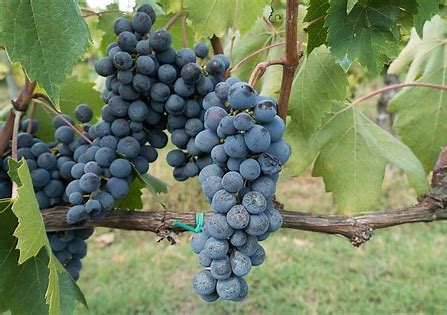Riverdene Garden Center
Blue Ice Grape
Blue Ice Grape
Couldn't load pickup availability
Vitis spp.
The Blue Ice Grape, also referred to as Morden Concord, is a cold-hardy grape variety developed for northern climates. It is known for its vigorous growth, sweet blue grapes, and reliable production even in regions with harsh winters. The high sugar content and juicy texture make it an excellent choice for fresh eating, juice, and jelly making. Its hardiness and adaptability make it well-suited for gardeners in Southwest Saskatchewan.
Planting & Growing Conditions
- Hardiness Zone: 3-8 (exceptionally winter-hardy, thrives in cold climates)
- Mature Size: 6 feet tall and wide
- Growth Habit: Vining, requires support
- Sunlight Needs: Full sun (at least 6-8 hours per day for best fruiting)
-
Soil Requirements:
- Prefers well-drained, fertile soil
- Tolerates loamy, sandy, or clay-based soils if drainage is adequate
- Avoid excessive fertilization, which can cause excessive leafy growth at the expense of fruit
-
Support Structure:
- Best grown on a trellis, fence, or arbor for optimal growth and airflow
- Spacing: 6 feet apart for proper growth and air circulation
Watering & Maintenance
-
Young Plants (First Year):
- Water deeply 2-3 times per week until roots are established
-
Mature Vines:
- Require consistent watering during flowering and fruiting (spring to early summer)
- Reduce watering in late summer to help fruit ripen
-
Mulching:
- Apply a 2-3 inch layer of mulch around the base to retain moisture and regulate soil temperature
Fertilization
- First Year: Avoid fertilizing to encourage root establishment
-
Annual Feeding:
- Apply a balanced fertilizer (10-10-10) in early spring to support growth and fruiting
- Use organic compost or manure to enrich soil health
- Avoid high-nitrogen fertilizers, which encourage excessive leafy growth
Pruning & Training
- Best Time to Prune: Late winter to early spring, before new growth starts
-
How to Prune:
- Remove dead, weak, or overcrowded branches to improve airflow and fruiting
- Train the strongest vines along a trellis or wire system for easy harvesting
- Thin out excess shoots to maximize sunlight exposure on developing grapes
Fruit & Harvesting
- Flowering: Late spring (small, inconspicuous flowers attract pollinators)
- Fruit Ripening: Late summer to early fall (September-October)
-
Berry Characteristics:
- Deep blue, medium to large-sized clusters
- Sweet, juicy, and firm texture, excellent for fresh eating, juices, and preserves
-
Harvest Tips:
- Pick when fully ripe (grapes should be deep blue with a sweet aroma)
- Best harvested by hand or using gentle shears
Pest & Disease Management
Resistant to: Cold temperatures and most common grapevine diseases
Common Pests:
-
Aphids & Leafhoppers – Can damage leaves and slow vine growth
- Solution: Use insecticidal soap or introduce natural predators like ladybugs
-
Birds & Wildlife – Love sweet grapes and may eat them before ripening
- Solution: Install bird netting or plant in a protected location
Common Diseases:
-
Powdery Mildew – Causes a white fungal coating on leaves in humid conditions
- Solution: Improve airflow and apply organic fungicides if needed
-
Botrytis Bunch Rot – Can affect clusters in wet weather
- Solution: Prune excess foliage to increase air circulation
Winter Care
- Highly winter-hardy, no special protection needed in Zone 3+
-
Mulching:
- Apply extra mulch in late fall to insulate roots in extreme cold
-
Pruning:
- Trim back weak or excessive growth in early spring to encourage strong fruiting
Landscape & Uses
Perfect for home gardens, edible landscapes, and small vineyards
Beautiful climbing vine for arbors, trellises, and fences
Reliable fruit producer with strong cold tolerance
Great for fresh eating, juicing, and jelly-making
Additional Notes:
- Alternative Names: Morden Concord
- Availability: Sold at specialty nurseries and prairie garden centers
- Lifespan: 20+ years with proper care
Photo courtesy of prairiegardens.org
Share


